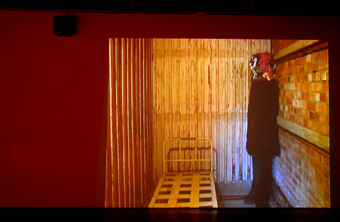 |
Austin McQuinn's Bogeyman photo Craig Opie |
Austin McQuinn's Bogeyman offers a particular vision of this place, a vision of Hobart, that is familiar and Other at once. A video projection introduces us to an odd figure constructed from dark cloth that covers the entire body except for the head, which comprises a clump of those old woollen CWA toys made into a slightly sinister amorphous blob. Interestingly, the use of old toys is fairly common round here, due in part to the presence of the Resource Tip Shop. The regular Art From Trash exhibitions usually feature something like the Bogeyman’s headpiece. But there’s more to this Bogeyman than his appearance.
He wanders out of place, pathetic and forlorn through regions that for me are rich with personal memory. I know the region of the mountain Bogeyman stands in, the steep street in South Hobart he carefully feels his way down, looking ever more awkward and displaced. I know which courthouse he’s been in, and I wonder if his story is formed in part by the sad tale of the Irish political exiles that ended up here. The guy who made the work is Irish after all, and for the purposes of this exhibition, the Irish are apparently Other as well.
So, the Bogeyman is alone in a place that I find so familiar. He doesn’t have my local know, is blind to the resonance and ripples that he creates, re-writing the landscape with his small presence. It’s a landscape he’s removed from—he can’t see, all his sensory equipment muffled by the thick black costume and the heavy headdress. He’s been made that way—he is a construction.
I see the places he’s in as some of the most obvious places an outsider would go when they come here; then I wonder if I’m being smug and insular. Maybe. Maybe I’m tired of the same story of this place being told by those from outside it. That’s if it is the same story, but if it is not, why do I recognise it? Even some things about the Bogeyman seem familiar. The way he seems to be put together, made out of residue, discard and children’s nightmares. I’ve seen him before somewhere; somewhere here. He’s unfamiliar and yet sympathetic in his lonely plodding. And I do think of him as character, yes, somehow. Somehow he takes that on in this work, bringing me back to where I sit, staring at him, wondering if his mere presence has re-written my home town even for me. I watch him sadly slide under a bed that no one sleeps in anymore.
That’s it. He was under my bed. He was under yours as well. Remember?
Austin McQuinn, Bogeyman, An Other Place, curated by Séan Kelly; Long Gallery, Salamanca Arts Centre, Ten Days on the Island, March 22-April 29
Andrew is a writer, a performer investigating hybrid and new forms, and an occasional producer and curator. He fluctuates between Hobart and Melbourne.
© Andrew Harper; for permission to reproduce apply to [email protected]








 back
back